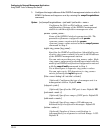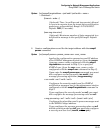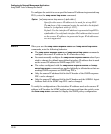
Configuring for Network Management Applications
Using SNMP Tools To Manage the Switch
Configuring SNMPv3 Notifications
The SNMPv3 notification process allows messages that are passed via SNMP
between the switch and a network management station to be authenticated
and encrypted.
To configure SNMPv3 notifications, follow these steps:
1. Enable SNMPv3 operation on the switch by entering the snmpv3 enable
command (see “SNMP Version 3 Commands” on page 13-6).
When SNMPv3 is enabled, the switch supports:
• Reception of SNMPv3 notification messages (traps and informs)
• Configuration of initial users
• (Optional) Restriction of non-SNMPv3 messages to “read only”
2. Configure SNMPv3 users by entering the snmpv3 user command (see
“SNMPv3 Users” on page 13-7). Each SNMPv3 user configuration is
entered in the User Table.
3. Assign SNMPv3 users to security groups according to their level of access
privilege by entering the snmpv3 group command (see “Assigning Users to
Groups” on page 13-10).
4. Define the name of an SNMPv3 notification configuration by entering the
snmpv3 notify command.
Syntax: [no] snmpv3 notify <notify_name> tagvalue <tag_name>
Associates the name of an SNMPv3 notification
configuration with a tag name used (internally) in
SNMPv3 commands. To delete a notification-to-tag
mapping, enter no snmpv3 notify <notify_name>.
notify < notify_name >
Specifies the name of an SNMPv3 notification
configuration.
tagvalue < tag_name >
Specifies the name of a tag value used in other SNMPv3
commands, such as snmpv3 targetaddress params taglist
<tag_name> in Step 5.
13-23


















